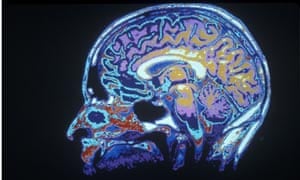 |
| Figure 1 - "An MRI scan highlights areas of activity" http://www.theguardian.com/science/2012/apr/29/neuroscience-guide-vaughan-bell |
Having studied neuroscience and psychology here at UCLA, I had not heard of any direct connection neuroscience has to art so this week’s lecture has been an eye-opening lesson for me. In Art, Mind, And Brain, Howard Gardner explains the “mystery of artistic creativity” and its links to the development of the brain of a child to an “artistically stunted” adult. What I find most enjoyable about his book is the lack of scientific jargon; Gardner often describes his complex and scientific thoughts using layman terms. Gardner states that a child “does not fully appreciate the rules and conventions of symbolic realms”, whereas adults “[are] fully cognizant of the norms embraced by others”; what this means to me is that while artistic adults can be trained to think outside-the-box, children don’t even have a box to repress their thoughts and creativity in the first place.
 |
| Figure 2 - Howard Gardner's Art, Mind, And Brain: A Cognitive Approach to Creativity http://ecx.images-amazon.com/images/I/41Fu3XJJDQL._SY344_BO1,204,203,200_.jpg |
Another aspect of that intrigues me is the way neuroscience is used to actually create art. Vesna mentions an artist called Suzanne Anker who created a collection of works, “fMRI Butterfly”, in which images of butterflies were superimposed onto brain-scans, creating a “subtle optical illusion” (Vesna). In Science and Society: Neuroculture, Giovanni Frazzetto explains that these were not just optical illusions but somewhat of a test of “underlying neurological processes at work in perception”.
 |
| Figure 3 - Butterfly in the Brain, 2007 by Suzanne Anker http://www.suzanneanker.com/artwork/?wppa-album=4&wppa-photo=275&wppa-occur=1 |
While not intentionally created as an art piece, the “Brainbow” has nevertheless showed the world how beautiful neuroscience can be. The “Brainbow” technique was developed by the Harvard Center for Brain Science in which “each individual nerve cell [was labelled] a different color to identify and track axons and dendrites over long distances” (Harvard CBS). The result is a colorful explosion of rain droplets which both intrigue and creep me out a little considering all of this is actually within our head.
 |
| Figure 4 - Hippocampus CA1 by J. Lichtman http://cbs.fas.harvard.edu/usr/connectome/brainbow/brainbow2.2.jpg |
Citations
- Center for Brain Science at Harvard University. "Brainbow." Brainbow. Center for Brain Science at Harvard University, n.d. Web. 17 May 2015. <http://cbs.fas.harvard.edu/science/connectome-project/brainbow#>.
- Frazzetto, Giovanni, and Suzanne Anker. "Science and Society: Neuroculture." Nature Reviews Neuroscience 10.11 (2009): n. pag. Nov. 2009. Web. 17 May 2015. <http://www.suzanneanker.com/wp-content/uploads/2009-Anker-Suzanne-Giovanni-Frazzetto-Neuroculture-Nature-Reviews.pdf>.
- Gardner, Howard. Art, Mind, And Brain: A Cognitive Approach to Creativity. New York: Basic, 1982. Google. Web. 17 May 2015. <https://books.google.com/books?id=2BMDYRRF1WcC&dq=gardner+%22art+mind+and+brain%22&printsec=frontcover&source=web&ots=DYaIMCGy4j&sig=8yrvOMWISopSrN_fNXsYqUPJCgw#v=onepage&q=gardner%20%22art%20mind%20and%20brain%22&f=false>.
- Levine, Michael S., and Joseph B. Watson. Lecture 1 - Introduction to the Brian and Brief History. Los Angeles: n.p., n.d. PPT.
- Neuroscience-pt1.mov. Perf. Victoria Vesna. YouTube. YouTube, 17 May 2012. Web. 17 May 2015. <https://www.youtube.com/watch?t=598&v=TzXjNbKDkYI>.
Hi Matt!
ReplyDeleteI really liked how your focus of this piece was on the usage of neuroscience in the development of art; while before, I had taken from this unit that art is a great pathway with which neuroscience can reach the public, this gives a whole new view of the intertwining of neuroscience, creativity and art. The usage of Suzanne Anker's fMRI butterfly images as an example is well contrasted with the Brainbow image developed at the harvard center of brain science. The fMRI butterfly images are an aesthetic piece derived from fMRI data overlaid with butterfly pictures. while the Brainbow is a result of dying various neurons a rainbow of color. These two examples are perfect for giving the full range of influence of neuroscience on art and vice versa: the fMRI butterfly is a symbolic aesthetic piece using resulting data from neuroscience work, while the Brainbow is just a beautiful accident resulting from the technological advancements in neuroscience research.